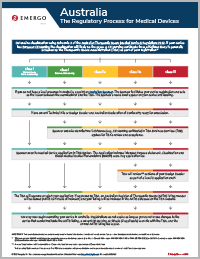澳大利亚TGA认证和医疗器械注册审批流程

此流程图阐明了澳大利亚每个医疗器械分类的TGA认证审批流程,可在法规事务管理平台(RAMS)下载。
有任何问题?向我们的专家获取相关信息
联系我们为了获得澳大利亚市场准入,医疗器械和体外诊断(IVD)器械制造商需要将他们的产品列入由药品管理局(TGA)监管的澳大利亚医疗用品登记表(ARTG)。
澳大利亚TGA医疗器械注册认证审批流程详解
此流程图阐明了澳大利亚每个医疗器械分类的TGA认证审批流程,可在法规事务管理平台(RAMS)下载。这里简要概述了注册流程的主要步骤。
第1步
根据澳大利亚分类规则判定您的器械的分类。
第2步
任命一名澳大利亚担保人管理您的器械注册,并代表您与TGA互动。
第3步
准备现有的技术文档和澳大利亚符合性声明以供递交给TGA。
第4步
除非您的器械属于最低风险类别,否则您的担保人将递交制造商的证据以供TGA审查和认可。
第5步
对于所有器械,您的担保人将递交一份医疗器械注册申请并支付注册费用。作为申请审核的一部分,TGA可能审查您的技术文档的各个部分。
第7步
审批后,TGA将签发ARTG列示编号给您,您的担保人可以在TGA企业服务网站上打印ARTG列示证书。
相关
-
美国FDA eSTAR电子递交模板与资源要求解析
自2018年起,美国食品和药物管理局(U.S. Food and Drug Administration,FDA)开始试行以电子化方式来帮助行业提供完整的510(k)上市前通知。2022年,为推进以电子格式提供510(k)递交文件的过渡,美国FDA正式发布关于使用电子递交模板和资源的最终指导文
阅读更多 -
IVDR过渡倒计时!欧盟体外诊断器械法规实施要点及合规挑战解析
新欧盟体外诊断器械法规(IVDR,In Vitro Diagnostic Device Regulation (EU) 2017/746)IVDR的发布为体外诊断器械医疗器械制造商满足欧洲市场合规带来新规实施、新旧过渡的诸多前所未有的挑战。对此,全球医疗器械及IVD器械合规专家Emergo b
阅读更多